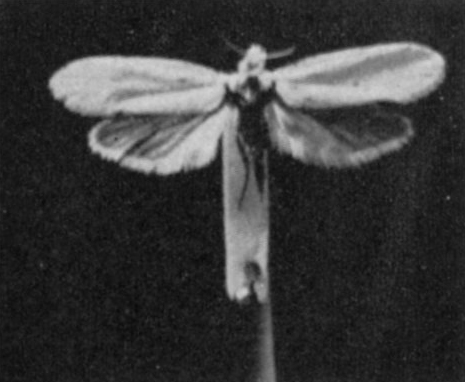- Prodoxidae
Taxobox
name = Prodoxidae
regnum =Animal ia

image_width = 250px
image_caption = Yucca Moth
phylum =Arthropod a
classis =Insect a
superordo =Amphiesmenoptera
ordo =Lepidoptera
subordo =Glossata
cohort =Myoglossata
subcohort =Neolepidoptera
infraordo =Heteroneura
superfamilia =Incurvarioidea
familia = Prodoxidae
diversity = About 80 species
diversity_link = Lepidopteran diversity
subdivision_ranks = Genera
subdivision = "Prodoxoides " "Lampronia " "Tetragma " "Greya " "Mesepiola " "Tegeticula " "Parategeticula " "Prodoxus " "Agavenema "Prodoxidae is a family of primitive
monotrysia nLepidoptera . Some of these small-to-medium sized moths are day flying, like "Lampronia capitella", known to European gardeners as the "Currant Shoot Borer" [http://ukmoths.org.uk/show.php?id=1443] . Others occur inAfrica andAsia ."Tetragma gei" feeds on Mountain Avens "Geum triflorum" in USA. "Greya politella" lay eggs in the flowers ofSaxifragaceae there. The last five genera listed here are confined to dry areas of the United States. "Prodoxoides asymmetra " occurs inChile andArgentina (Nielsen and Davis, 1985), but all other prodoxid moth genera have a northern distribution."Yucca Moths" have a remarkable biology. They are famous for an old and intimate relationship with
Yucca plants and are theirobligate pollinators as well asherbivores (Pellmyr et al., 1996). Interactions of these organisms range fromobligate mutualism tocommensalism to outrightantagonism . Their bore holes are a common sight on trunks of such plants as theSoaptree yucca . Two of the three yucca moth genera in particular, "Tegeticula" and "Parategeticula", have an obligate pollination mutualism with yuccas. Yuccas are only pollinated by these moths, and thepollinator larva e feed exclusively on yuccaseed s. Species of the third genus of yucca moths, "Prodoxus", are not engaged in the pollination mutualism, nor do the larvae feed on developing seeds. Their eggs are deposited infruit s and leaves, where they eat and grow, not emerging until fully mature.References
*Davis, D.R. (1999). The Monotrysian Heteroneura. Ch. 6, pp. 65-90 in Kristensen, N.P. (Ed.). "Lepidoptera, Moths and Butterflies". Volume 1: Evolution, Systematics, and Biogeography. Handbuch der Zoologie. Eine Naturgeschichte der Stämme des Tierreiches / Handbook of Zoology. A Natural History of the phyla of the Animal Kingdom. Band / Volume IV Arthropoda: Insecta Teilband / Part 35: 491 pp. Walter de Gruyter, Berlin, New York.
*Nielsen, E.S. and Davis, D.R. (1985). The first southern hemisphere prodoxid and the phylogeny of the Incurvarioidea (Lepidoptera). "Systematic Entomology", 10: 307-322.
*Pellmyr, O., Thompson, J.N., Brown, J. and Harrison, R.G. (1996). Evolution of pollination and mutualism in the yucca moth lineage. "American Naturalist", 148: 827-847.
* Pellmyr, O., J. N. Thompson, J. Brown, and R. G. Harrison. (1996). Evolution of pollination and mutualism in the yucca moth lineage. "American Naturalist" 148: 827–847.
* Powell, J. A. (1992). Interrelationships of yuccas and yucca moths. "Trends in Ecology and Evolution" 7: 10–15.External links
* [http://tolweb.org/Prodoxidae Tree of Life Comprehensive overview of Yucca Moths]
* [http://ukmoths.org.uk/search.php?entry=Lampronia UK Moths "Lampronia"]
* [http://www.tolweb.org/Tetragma_gei/12412 "Tetragma gei"]
* [http://tolweb.org/Greya_politella "Greya politella"]
* [http://www.tolweb.org/Agavenema_sp./12423 "Agavenema"]
* [http://www.biology.vanderbilt.edu/BIO/ToLProdox/prodoxoides_asymmetra.html "Prodoxoides asymmetra"]
Wikimedia Foundation. 2010.
